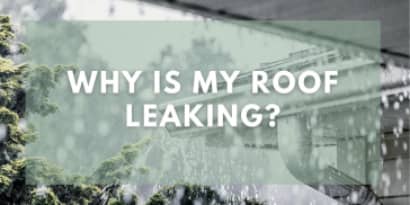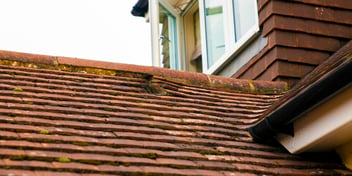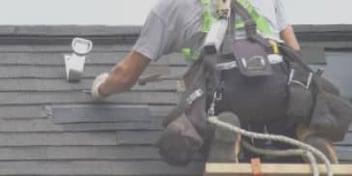- Home »
- Learningcenter »
- Why is my roof leaking
Why Is My Roof Leaking?

Roof Leaks - How To Spot Them, Why They Happen, And What To Do Now
Finding out your roof is leaking is never fun - and as a home owner, we understand that this can cause a lot of stress and anxiety. Fortunately, roof leaks are easy to spot. Sometimes the hard part can be figuring out what's causing them, but here at Colony Roofers, we want to help you take the guesswork out of a leaky roof. Keep reading to learn all about leaky roofs: , the most common causes of roof leaks, and what to do when your roof is leaking.
How do I know if my roof is leaking?
This one is fairly straightforward to answer. The most telltale and reliable sign of a roof leak is always going to be water spots on your interior ceiling. If you see brown stains in the shape of puddles with faint rings around the edges, those are definitely water stains.
Another telltale sign of a roof leak is buckling or curling shingles. Shingles are your roof's main line of defense against water, and if they are curling upwards there's a good chance they could be letting water in.
A few more signs of a potential roof leak are mold growing on exterior walls, wet or rusty pipes (such as the stove pipe on your fireplace), and drips. If you hear any kind of dripping but can't find the source, it's important to check your roof for leaks immediately.
Most Common Causes of Roof Leaks
Pipe Boot Failure
The most common cause of minor roof leaks is Pipe Boot failure. A pipe boot is a type of roof flashing that surrounds the base of pipes that go through your roof and creates a waterproof seal. A pipe boot's main purpose is to keep water from following the pipe down through your roof into your home.
The reason these fail so frequently, is that many pipe boots are made of rubber, and the UV rays from the sun degrade the material over time and it ends up cracking. The crack will allow water to run down into whatever space in your home the pipe runs through. These types of leaks can show up anywhere in your home that a pipe is located, and this will vary from home to home.
Unfortunately, pipe boots will not last as long as your roof will. The compounds they are made from have been updated by manufacturer's over the years, but ultimately they still wear more quickly than your shingles. Fortunately, this is one of the easiest leaks to fix, and the cracked part of your pipe boot is repaired with a rubber collar that will seal it against water, and should give you another 10-15 years.
Popped Nails
While pipe boot failure is still the most common cause of roof leaks, the second most common cause is going to be nail pops. When your roof is installed, the shingles are nailed down into place - over time and with changing weather conditions, your roofing materials expand and contract, which sometimes cause the nails to work their way back up and out of the roof. When this happens, the seal the head of the nail creates with the shingle is broken, and water will be caught by the nail head and can follow the nail down into your roof causing leaks.
These leaks can show up anywhere in your home, because it's going to depend on the location of the improperly driven nail. This leak is another easy fix however, and a roofer will come out and remove the nail, properly drive a new one, and reseal the shingle if necessary.
Shingle Damage
Broken or missing shingles are a huge risk factor in roof leaks. As your roof ages, the special oils in the shingles that allow them to expand and contract with fluctuating weather conditions can dry out and cause shingles to become dry leading to cracking, curling, breakage, and loss of granules, all of which affect their water shedding ability.
This kind of leak can be repaired in the spot where the leak is coming from, but if aging shingles are the cause of one leak they will likely be the cause of another sooner rather than later. In this instance, a repair may simply buy you a little time when a roof replacement is what's ultimately necessary.
Debris In Gutters
Another common cause of roof leaks is debris caught in your gutters. If your gutters can't drain water properly and route it away from your house, your roof can be prone to leaking. This is especially true when the debris get caught above your roof line under a valley. A valley is where two slopes of your roof meet, creating a V shape and allowing water to run down. Many times there will be a gutter below this, allowing the water to keep flowing off of and away from your roof. When debris get caught in your gutter in this area, the water still needs somewhere to go, and it will choose the path of least resistance. This is typically going to be through the soffit and fascia (especially when there is improperly applied flashing), and once those are breached, the water can end up anywhere.
This is an important leak to have fixed quickly, because the fact that the water gets behind the gutters and inside the roof means it can cause all kinds of damage. To fix this leak, a roofing contractor will remove the gutter in the affected area, install three pieces of flashing to seal it from water, and put the gutter back on.
Cracked Flashing
Roof flashing is a thin material used to direct water away from critical areas of the roof, like where a slope meets a flat surface, and surrounding pipes and chimneys. If this flashing becomes cracked or damage, your roof will be particularly vulnerable to leaks. A trained roofing contractor can easily fix this problem by replacing old flashing with new flashing that is not damaged and sealing it properly.
Older Chimneys
Many times, when your chimney begins to show signs of wear and tear, it can be the cause of a roof leak. These leaks can happen for a couple of reasons. The mortar joints (and even the bricks themselves) can be absorbing water and allowing it to get into your home, the masonry top can crack with age and allow water down through the top of your chimney, the metal flashing around the base of your chimney can come loose, or if you have a chimney with siding, water can get trapped where the siding meets the corner boards, causing the boards to rot.
In order to get these leaks repaired, you'll typically have to hire a carpenter (for chimneys with siding) or a chimney company. Roofers will be able to diagnose this leak for you, but most roofers don't have the licenses and insurance required to perform these kinds of repairs on a chimney.
Skylights
Skylights are another common cause of roof leaks, not necessarily because they are inherently leaky, but because many times the installer doesn't read and properly follow the manufacturer's installation instructions. In order to fix this kind of leak, the cladding and flashing kit need to be removed from the skylight, an ice and water shield need to be applied, and then the flashing is reinstalled.
Gas Vent Collar
Another common cause of roof leaks is a collar failure around a gas vent. Because gas vents are not installed by roofing contractors, and are installed after the roof is complete by HVAC companies, often times they are not properly trained on roofing techniques and so they may be poorly protected against leakage, especially in heavy rain. This is a tricky leak for a roofer to repair since it involves an HVAC component, but it can be done carefully by sliding up the collar and sealing the pipe.
Poor Roof Maintenance
One of the most import parts of prolonging the life of your home's roof is making sure to maintain it properly. Not having your roof regularly cleaned and inspected by a trusted and licensed roofing company can lead to any of the problems in this list and more, causing a lot more damage in the long run. Having your roof routinely maintained and inspected can diagnose potential problems like these early on and avoid bigger issues in the long run.
What To Do If Your Roof Is Leaking
If you find yourself with a roof leak, the first question you probably want to ask is: what do I do now? It's important to get the leak diagnosed and repaired as quickly as possible, because you don't know what hidden damage is being caused by the presence of water underneath your roof. If there is one leak in your roof, there's a chance another one is not far behind, so having a thorough inspection done by a licensed roofing contractor is the smartest thing you can do. From there you'll be able to find out if your leak can be repaired, or if a roof replacement is necessary to fix the problem. At Colony Roofers, we pride ourselves on being a name you can trust in the roofing industry. We offer free 30 minute inspections, and we're always happy to come out and take a look at any issue you may have.
 Call (678) 365-3138
Call (678) 365-3138
.jpg?width=352&height=352&name=roof%20leaks%20(1).jpg)

